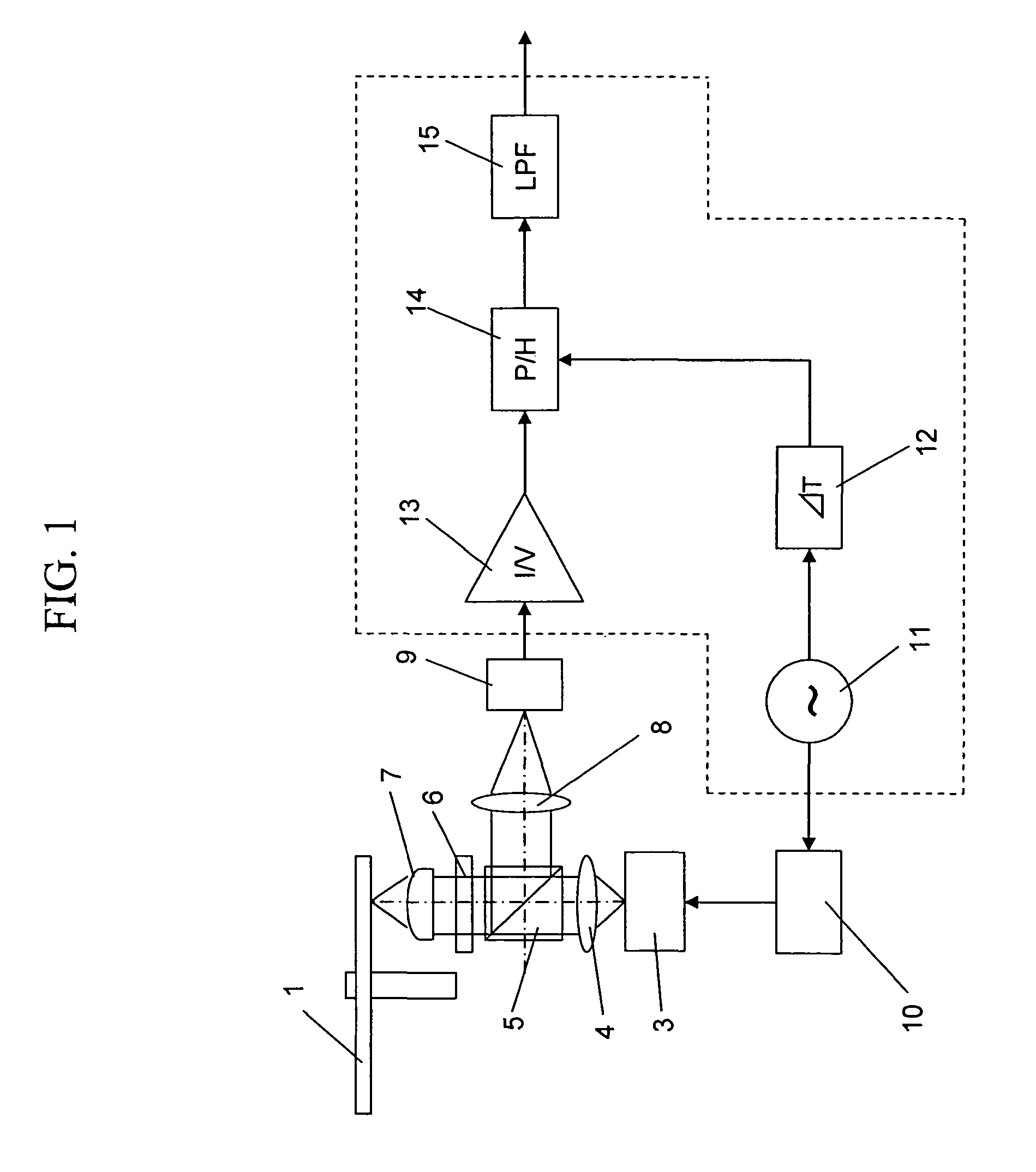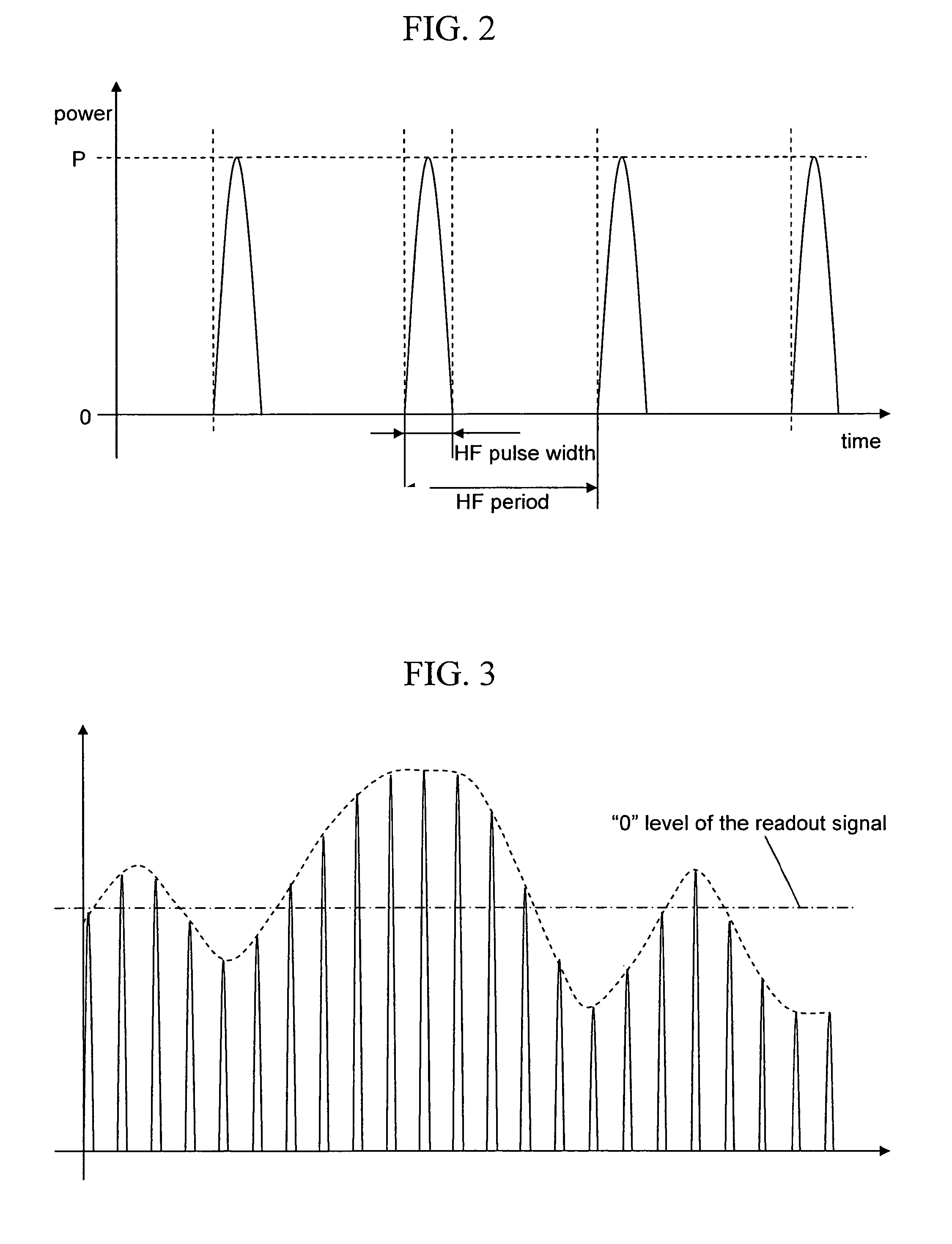Optical disk device and integrated circuit used therein
a technology of optical disk and integrated circuit, which is applied in the field can solve the problems of difficult to separate the baseband readout signal and the high-order spectrum, and employ high-frequency modulation, so as to reduce the impact, increase the readout speed factor of optical disk devices, and effectively restrict line and other distortion spectrum components
- Summary
- Abstract
- Description
- Claims
- Application Information
AI Technical Summary
Benefits of technology
Problems solved by technology
Method used
Image
Examples
first embodiment
[0028]FIG. 1 is a view showing a frame format of one example of an optical disk device according to the present invention. Note that in this figure, aspects not necessary for the following explanation have been omitted, and mainly the pickup is described. The present embodiment employs a peak hold circuit 14 as a means for converting the pulse readout signal to a continuous waveform. Note that the pulse readout signal is composed of a pulse train that is discrete in time, and the essences of the signal are in the time and the peak value of each pulse. In contrast, the continuous signal referred to herein is meant to be composed of not only components essentially discrete in time (pulses) like the pulse readout signal, and has a broader meaning than the ordinary meaning of a continuous signal. Therefore, it includes cases when the signal amplitude suddenly becomes 0 in a short time period.
[0029]The high-frequency modulating signal (HF signal) is generated in an HF oscillator 11 and i...
second embodiment
[0040]FIG. 9A is the peak hold circuit output spectrum when the present invention is applied to a 12× readout BD. From the perspective of laser noise, it was assumed that the HF frequency could not be moved very far from around 400 MHz. Accordingly, although the channel clock frequency was 792 MHz, and the 2 T frequency was 198 MHz, the HF frequency was set at 528 MHz. In this way, according to the present invention, it is possible to set the HF frequency lower than the channel clock frequency. Considering the two factors; the possibility of achieving latter stage low-pass filter properties and the overlapping of the signal spectrum below the optical cutoff frequency, we used a 6th-order Bessel low-pass filter with a cutoff frequency of 250 MHz for the final stage low-pass filter. FIG. 9B shows the spectrum after passing through the low-pass filter. According to this, the distortion component spectrum closest to the readout signal bandwidth is approximately 40 dB lower than the read...
third embodiment
[0042]FIG. 10 is a view showing a frame format of another example of a disk drive according to the present invention. In this embodiment, each pulse of the pulse readout signal is directly converted into digital data. The process by which the HF laser pulse is converted into an electronic signal is the same as explained in the first embodiment, so explanation is omitted here. The output of the current amplifier 13 is inputted into the peak hold circuit 14 after passing through a variable gain amplifier 32. The gain of the variable gain amplifier 32 is indicated based on the readout signal amplitude detected in the signal processing system.
[0043]Usually, with an analog to digital converter, which converts analog signals to digital signals, since the subject is a continuous signal, first, amplitude information is held for a set period of time in the sample hold circuit, and then the values held for that time are converted into digital data. The mechanism that performs the latter proce...
PUM
| Property | Measurement | Unit |
|---|---|---|
| frequency | aaaaa | aaaaa |
| HF frequency | aaaaa | aaaaa |
| HF frequency | aaaaa | aaaaa |
Abstract
Description
Claims
Application Information
 Login to View More
Login to View More - R&D
- Intellectual Property
- Life Sciences
- Materials
- Tech Scout
- Unparalleled Data Quality
- Higher Quality Content
- 60% Fewer Hallucinations
Browse by: Latest US Patents, China's latest patents, Technical Efficacy Thesaurus, Application Domain, Technology Topic, Popular Technical Reports.
© 2025 PatSnap. All rights reserved.Legal|Privacy policy|Modern Slavery Act Transparency Statement|Sitemap|About US| Contact US: help@patsnap.com



